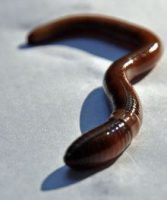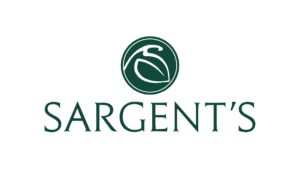Getting a Jump on Jumping Worms
Amynthas — also known as jumping worms — are named as such because of how they move when disturbed. They are classified as an invasive species by the Minnesota Department of Natural Resources and have existed in Minnesota since at least 2006. They were discovered in Olmsted County in 2018, although they likely have been here much longer. As with many other invasive species, jumping worms are already prevalent in many areas around MN and are expected to become as common as Japanese beetles or buckthorn.

Jumping worms have been on our radar at Sargent’s for several years. Because of their prevalence in our area, Sargent’s felt it was our responsibility to regularly monitor for jumping worms on our property and job sites. Throughout the 2021 season, Sargent’s staff confirmed the presence of jumping worms on a significant number of residential properties. More recently, they have also been identified in isolated locations at both Sargent’s retail locations. This discovery was immediately self-reported to the appropriate agencies: the MN Department of Agriculture and the MN Department of Natural Resources. While these discoveries are unfortunate, they are not unexpected.
Sargent’s has been a key supplier of top-quality plants and gardening materials in Southeastern Minnesota for 50 years. As the experts, we feel uniquely suited to tackle this issue head on and remain a premier source for safe, clean, and reliable plant material and outdoor products. Read on to learn about the risks of jumping worms and how Sargent’s is stepping up to slow the spread.
Impact on Soil
It is important to understand that all worms found in Minnesota are invasive. There are no native species of earthworms in this area. Like all earthworms, these worms dramatically change soil characteristics. This in turn can change the types of plants and animals that can survive in that soil.
Fortunately, these worms stay in the top couple inches of soil. Since most plants have deep root systems, they are unlikely to be severely affected by amynthas. Experts are still researching the long-term impact these worms will have on landscape plants.
How They Spread
Jumping worms are active worms that can travel great distances (longer than a city block) in a short amount of time. Their ideal habitat is leaf litter and other decomposing woody material such as mulch or woodchips. Initial research suggests that nearby jumping worms will seek out freshly laid mulch or similar materials.
Human interaction is another major conduit for jumping worm spread. Neighborhood plant shares, lawn mowing services, landscaping, transport of construction material, even just walking or driving from one area to the next can transport the cocoons of these worms. Any person, tool, machine, or soil moving from one yard to another is a possible source of transmission.
Currently, there is no official estimate on the number of homes that have jumping worms, but the consensus from experts is that number is “significant”. It’s hard to get an exact number as the vast majority of cases go undetected and thus unreported.
How to Stop the Spread
The best defense against jumping worms is preventing their spread. Homeowners should avoid sharing plants, or at a minimum only share clean, bare-root plants. Furthermore, homeowners concerned about jumping worms should shop at nurseries and garden centers that are taking proactive steps to mitigate the spread.
Commercial operations that deal with organic matter that can spread jumping worms should follow the best management practices set forth by the Minnesota Nursery and Landscape Association. This includes washing all machinery and tools — including lawn mowers, trenchers, and skid loaders — when going from one job site to another. It also means performing regular inspections of salable products such as plants and bagged mulches.
Currently, the only approved way to kill these worms is heat. The cocoons die at 104 degrees, and the worms die at 130 degrees. But there’s hope that soon we’ll have another treatment option. Research is currently underway by the University of MN and the University of WI to test additional treatments.
Our Commitment to You
Sargent’s is committed to mitigating the spread of jumping worms in MN and remaining the source of knowledge, quality, and service that you’ve come to expect. To that end, we are meeting or exceeding all Dept. Of Agriculture directives and recommendations, as well as the Best Management Practices set forth by the Minnesota Nursery & Landscape Association. A detailed description of these practices can be found below.
Sargent’s will continue to work with the Minnesota Department of Agriculture, the University of Minnesota, and other industry leaders to remain at the forefront of this issue. We are committed to minimizing the spread of jumping worms and to keeping your gardens, and ours, flourishing for decades to come.
You can learn more about jumping worms from the Minnesota DNR and University of Minnesota.
MNLA Best Management Practices
Below are the best management practices currently implemented by Sargent’s.
- Provide and review education materials with current staff and incorporate those materials into new hire documents. Subject matter should include:
- Risks and impact of jumping worms
- Means of spread
- Identification and signs of their presence
- Observe for signs of jumping worms at jobsites
- Inspect and clean all equipment and tools between jobsites in accordance with ‘soil-free’ policy
- Only sell, plant, and buy plants and organic material that ‘appears to be jumping worm free’
- Perform weekly inspection of salable products such as plant material and mulch
- Only buy from reputable, knowledgeable vendors
- Perform regular test of bulk mulch temps – heat to appropriate levels
- Store all plant material and bagged organic material in a manner that avoids contact with ground soil
- Properly dispose of any material suspected of containing jumping worms
These BMPs are adapted from jumping worm best management practices originally developed by the Wisconsin Department of Natural Resources and a committee of Wisconsin green industry professionals and have been reviewed by horticultural professionals and MNLA partners at the local and national level.
We are following the MNLA best management practice that reads:
“Arrive clean, leave clean; always clean soil and debris from vehicles, equipment, tools, and personal gear (footwear, gloves, clothing) before moving from one location to another”
Standard practice:
- All vehicles and equipment that leave paved surfaces are scraped clean of soil and power washed upon return to the nursery
- All equipment that stores or hauls soil debris at a jobsite is scraped clean and inspected, and if it cannot be removed with scraping it is power washed upon return to the nursery and inspected. i.e. dump truck beds, tractor or loader buckets, digging equipment
- Footwear and tools are scraped clean with boot cleaner upon return to the shop and inspected
- When a crew moves from one site to another without return to the nursery extra attention is giving to cleaning soils from vehicles, equipment, footwear, and tools and inspecting
- Exterior of B&B root balls are washed, trimmed and washed a second time to remove any exterior soil debris then inspected for soil and worms
Sites where jumping worms are suspected:
- All vehicles and equipment the leaves paved surfaces, or hauls soil debris are power washed upon return to the nursery and inspected
- All tools are scraped clean of debris and power washed and inspected
- Soil debris is left on site whenever possible
- Any soil debris that is returned to the nursery is quarantined on top of plastic in a contained bin in nursery yard and treated with heat
